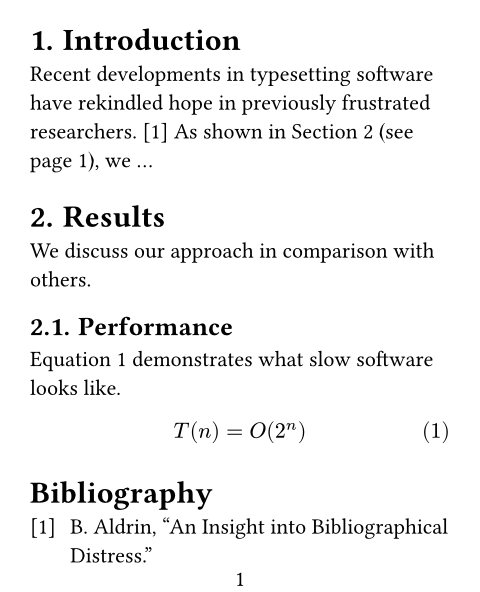このページは日本語に翻訳済みです。
ref要素関数要素関数要素関数はsetルールやshowルールでカスタマイズできます。
setルールやshowルールでカスタマイズできます。ラベルや参考文献への参照。
ラベルを指定して、その参照を生成します。
参照のformには"normal"と"page"の2種類があります。
デフォルトの"normal"参照では、ラベルに対するテキスト形式の参照が作られます。
例えば見出しへの参照なら、"Section 1"などのような適切な文字列が表示されます。
この参照は、該当する要素へのリンクとしても機能します。
また、参照の構文は文献リストからの引用を行うciteにも使用できます。
このデフォルト形式では補足語と番号が必要なため、ラベルは 参照可能な要素 に付けなくてはなりません。
参照可能な要素としては、
headings、figures、equations、footnotes
などがあります。
定理(theorem)などのカスタム参照可能要素を作成したい場合は、カスタムkindの図表として作成し、それに対応するshowルールを書くことで作成可能です。
将来的には、カスタム参照可能要素をもっと直接的に定義する方法が導入されるかもしれません。
例
#set page(numbering: "1")
#set heading(numbering: "1.")
#set math.equation(numbering: "(1)")
= Introduction <intro>
Recent developments in
typesetting software have
rekindled hope in previously
frustrated researchers. @distress
As shown in @results (see
#ref(<results>, form: "page")),
we ...
= Results <results>
We discuss our approach in
comparison with others.
== Performance <perf>
@slow demonstrates what slow
software looks like.
$ T(n) = O(2^n) $ <slow>
#bibliography("works.bib")

Syntax
この機能には専用の記法も用意されています。
"normal" の参照を作成するためには@に続けてラベル名を入力します。
(例えば= Introduction <intro>というラベルを参照するには@introと入力します)
補足語をカスタマイズするには、
@intro[Chapter]のように、参照の後に角括弧でコンテンツを追加します。
カスタム
参照のshowルールを書く場合、
参照のelementフィールドを通じて参照先の要素にアクセスできます。
ただし、Typstがまだそれを発見していない場合、elementは存在していてもnoneになる可能性があるため、
常にコード内でそのケースを処理する必要があります。
#set heading(numbering: "1.")
#set math.equation(numbering: "(1)")
#show ref: it => {
let eq = math.equation
let el = it.element
if el != none and el.func() == eq {
// Override equation references.
link(el.location(),numbering(
el.numbering,
..counter(eq).at(el.location())
))
} else {
// Other references as usual.
it
}
}
= Beginnings <beginning>
In @beginning we prove @pythagoras.
$ a^2 + b^2 = c^2 $ <pythagoras>

引数引数引数は関数への入力値です。関数名の後に括弧で囲んで指定します。
ref(,,form:)->target
target参照されるべき対象ラベル。
これは、ドキュメント内で定義されたラベルや、
参考文献リストの参照キーである場合があります。
例を表示
#set heading(numbering: "1.")
#show ref.where(
form: "normal"
): set ref(supplement: it => {
if it.func() == heading {
"Chapter"
} else {
"Thing"
}
})
= Introduction <intro>
In @intro, we see how to turn
Sections into Chapters. And
in @intro[Part], it is done
manually.

デフォルト値:auto
form設定可能引数設定可能引数設定可能引数は、setルールを用いて設定でき、それ以降で使用するデフォルト値を変更できます。
formsetルールを用いて設定でき、それ以降で使用するデフォルト値を変更できます。生成する参照の種類
例を表示
#set page(numbering: "1")
Here <here> we are on
#ref(<here>, form: "page").

使用可能な文字列値
normalラベルに対して文字列での参照を生成します。
pageラベルに対してページ番号での参照を生成します。
デフォルト値:"normal"